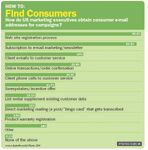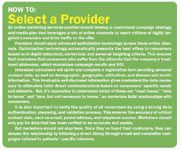Alternative Media: How to Capture Your target Consumers' Profile Data Online
Pharmaceutical Executive
Since each consumer has unique preferences and online habits, marketers should leverage a variety of channels to capture a high volume of targeted consumer profile data, without jeapordizing the quality of their lists.
Most pharma marketers use the same methods to gather consumer data. Through Web site registration, subscriptions to e-mail newsletters, and customer-client requests for customer service—the three most popular ways that marketers get consumer information, according to a November 2004 Jupiter Research Study—pharma companies can secure valuable data, such as the e-mail addresses and profile information of their target audience: people who suffer from specific ailments.

Jere Doyle
While marketers tend to believe these methods deliver good data, many have yet to figure out how to leverage this information to gain new customers. To better target and keep track of consumers, some pharma companies have developed online customer-acquisition programs, a marketing approach that
identifies consumers (and their loved ones) who are interested in learning about drug treatments for their specific ailments. After identifying these consumers, marketers can invite them to try their drug, and over time, build consumer loyalty to their brand. These programs can help pharma marketers reach new prospects, build trusting relationships with individual consumers, and secure permission to continue contacting them with the types of drug treatment information that match their interests and medical needs.
Develop a List of Prospects
Marketers can begin the online acquisition process by developing an in-house list of consumers who suffer from the ailment that their brand treats. This "house list" should be a dynamic, constantly updated and evolving database containing customer profile data.
Marketers should explore multiple online channels to gather and qualify the consumer data that goes into building and maintaining a list. These channels include e-mail, paid searches, vertically targeted Web sites and brand-specific sites, co-registrations, and online surveys and polls. Since each consumer has unique preferences and online habits, marketers should leverage a variety of channels to capture a high volume of targeted consumer profile data, without jeopardizing the quality of their lists.

Find Consumers
In addition to obtaining a robust list of consumer data, a successful online acquisition program requires strategy, media buying, targeting, data collection, and verification. Marketers should also employ advanced data-validation techniques to ensure the accuracy of their consumers' personal information and contact data. Third-party databases can help verify this information.
Measure the Campaign
Finally, marketers should conduct an in-depth analysis of all aspects of the campaign. Measuring campaign performance, including response rate, cost per lead, conversion rate, and revenue by source, can help improve the effectiveness of future campaigns. Pre- and post-campaign analysis also provide valuable intelligence. For example, using polling, a control group can be established prior to the campaign to determine consumers' pre-campaign buying behaviors. After completing the campaign, marketers can compare the initial baseline data with the final campaign data to determine the resulting "lift," the impact of the campaign on purchasing behavior.

Select a Provider
To ensure the success of an online customer acquisition campaign, pharma marketers should abide by the following principles:
Seek permission A quality database must be permission-based. Once the consumer has provided explicit permission to use his or her personal information, marketers can build a long-term, profitable relationship.
Precisely target Only go after those consumers that suffer from the ailments that your drug treats.
Respect privacy Marketers must definitively state through a clear and simple privacy policy how consumers' personal information will be used. Without building this trust, the relationship will suffer.
Communicate meaningful messages Deliver relevant, compelling messages about consumers' specific ailments. Busy consumers only want to receive information or offers that interest them. This will increase the likelihood of response.
Give consumers final authority Give consumers what they want: control. Let them express which drug treatments and information interest them, how they want to receive it, and how frequently. Offering them an easy opt-out or unsubscribe will make them feel empowered.
Customer-acquisition campaigns will continue to gain momentum in the pharmaceutical industry, as marketers realize the importance of expanding their in-house files to generate a constant stream of new customers. New consumer-generated digital channels, such as blogs and RSS, will help drive this trend, since they can deliver information directly to consumers' computers and mobile devices.
Most important, online acquisition strategies integrate well with a company's other marketing strategies, including DTC television and print advertising. A tightly integrated strategy can help yield higher response rates and conversions in a company's customer acquisition program.
Jere Doyle is president and CEO of Prospectiv. He can be reached at jdoyle@prospectiv.com

Is Artificial Intelligence a ‘Product’? Products Liability Implications for AI-Based Products
April 10th 2025As the physical products we use evolve to become increasingly complex, traditional products liability frameworks may not always fit to provide remedies for harm that can result from using novel product types.